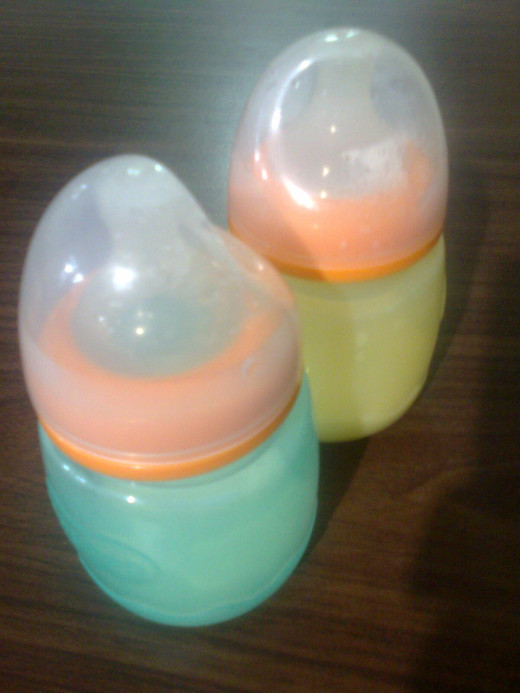How Long Can You Store Breast Milk - Appropriate Storing, Thawing and More

First things first, breast milk is best for babies. We've seen it, heard it, and some take heed. But not all babies are fortunate enough to drink their mom’s milk. The reasons vary from lack of time to some horrid medical conditions. But even if you’re lucky to breast feed, your schedule can be a burden. For such instances, expressing milk in advance is a solution. Of course, there’s another drawback here – storing the milk. You just can’t run home every time you express milk. Sure FedEX and UPS can be an option. But seriously, if you're a working mom, this is just a huge problem. My wife had to squeeze in pumping for milk in between her work. Apart from the pain when engorged with milk, the importance of giving breast milk to our baby comes in as first priority.
Unlike powdered milk which you can simply mix when needed, breast milk does not have that feature. Powdered breast milk - that's a thought! Proper handling and storing of breast milk is without a question one of the most important info breastfeeding moms should know.

Storage location and duration
Breast milk straight from the mom is always best. But there are times when you have to collect it and express ahead of time. For such instances proper storage and awareness of its lapse time is important.
Counter tops
Storing breast milk at room temperature is acceptable if you will use it immediately. However, if you intend to use it several hours after expressing the milk, it’s best stored in the refrigerator. Another concern is the actual room temperature. Depending on your location, the temperature can be 25°C or even warmer. In tropical countries, the average temperature during summer can reach 30°C or higher. Just as a rule of thumb, storing your baby’s milk at 77°F will buy approximately 6 to 8 hours before you need to throw the milk. Remember, temperature from place to place vary. As such, let your baby drink the milk as soon as possible.
Caution:
Different places have different average room temperature. The higher the temperature the faster the milk will spoil. Other conditions also come into lay like humidity and even cleanliness of the container and the surrounding. Even the manner of handling of the milk comes into play..
Coolers
Coolers are a great way to store breast milk especially if you are on the go. An insulated cooler container can have a temperature of around -150F to 40F. This range will give you a storage time of up to 24 hours.
Caution:
Check the actual temperature rating of your cooler as this may differ. Cooler materials, wear and tear of the container affect the internal temperature. Keep in mind that If you frequently open your cooler it can drastically change the temperature.

Refrigerators
Placing the breast milk in the refrigerator increases the storage time. Your ref will most likely have a temperature of 39°F or 4°C. At this temperature, the milk can be stored up to 5 days. If you plan to store the milk in the refrigerator for extended period, make sure you place the bottle at the back end. This will ensure constant temperature.
Caution:
Label your bottles so you‘ll know when you should use the milk. It is easy to forget that you have a bottle in your ref. So it will be a good idea to post a reminder on your refrigerator’s door. Take note of when you placed it and its lapse date. You can label the milk container as well.
Freezers
Freezers are a great way to store breast milk as they provide lower temperature. However not all freezers are the same. The storage time of the breast milk will depend on the type of freezer that you have.
For freezers of single door refrigerators, the temperature can be as low as 5°F or -15°C. Breast milk can last up to 2 weeks in here. On the other hand, freezers of two-door ref have a temperature of 0°F or -18°C. Here, you can store milk for 3 to 6 months. Lastly, a chest type freezer or deep freezers can provide a chilling -4°F or -20°C. Your milk will last from 6 to 12 months.
Caution:
Although milk is still safe to drink when stored at freezing temperature, some proteins in the milk may degrade. It's easy to forget which should be consumed first. As such, label, label and label some more.
Thawing the frozen breast milk
When you freeze the breast milk, thawing it properly is important. The safest way to thaw milk is to place it in the main compartment of your refrigerator and let it slowly thaw. However, if time does not permit this you may opt to place the bottle in a bowl filled with warm water. Swirling it around the warm water can speed up the thawing process. Microwaving the bottle is not recommended.
Furthermore, once the milk is thawed, it is not a good idea to refreeze it. Suffice to say, once thawed, it has to be consumed.
Storage Duration Quick Reference
Location
| Temperature
| Duration
|
|---|---|---|
Countertops
| 77°F or 25°C
| 6 to 8 hours
|
Coolers
| 5 to 39°F or -15 to -4°C5-39°F
| 24 hours
|
Refrigerator
| 39°F or -4°C
| 5 days
|
Ref’s freezer compartment
| 5°F or -15°C
| 2 weeks
|
Freezer (ref with separate freezer door)
| 0°F or -18°C
| 3-6 months
|
Chest type freezer
| -4°F or -20°C
| 6-12 months
|
IMPORTANT NOTE:
Always consult with your pediatrician regarding breastfeeding, handling and storing of milk.
Additional tips
- Clean your breast pump before using. Check if it can be sterilized.
- Wash your hands and wipe your breast before extracting milk.
- Use sterilized bottles or milk containers. Allow the container to cool down first before transferring the milk
- Properly seal the container. Seal the container so it will not be contaminated with other food particles or whatever is in your freezer or refrigerator.
- Label the containers. Ideally, write when you expressed the milk. This way you have an idea when the milk has to be consumed.
- First in First out.
- Make a tally of the bottle in storage and place it on your ref door.
All parents want the best for their babies – giving breast milk included. Proper storage ensures that your baby gets safe milk to drink.








